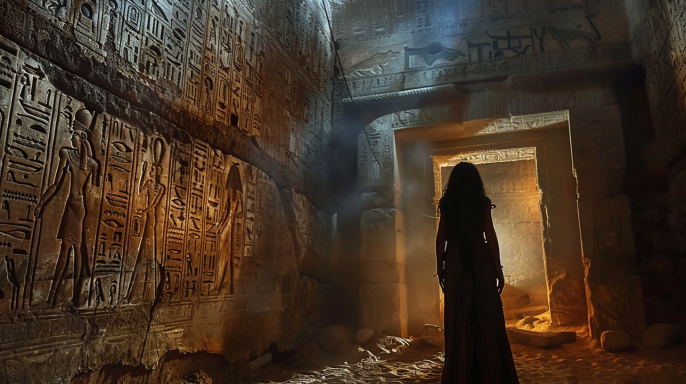Introduction
Cleopatra, the last Pharaoh of Egypt, is one of history’s most famous figures. After her death in 30 BCE, her tomb, shared with her lover Mark Antony, was reportedly hidden to protect it from looters. Despite extensive searches, the location of Cleopatra’s tomb remains undiscovered. This article explores the history, theories, and ongoing search for Cleopatra’s final resting place.
Historical Background
Cleopatra VII Philopator ruled Egypt from 51 BCE until her death. Known for her intelligence, political acumen, and romantic liaisons with Julius Caesar and Mark Antony, Cleopatra’s legacy has endured for millennia. Her reign marked the end of the Ptolemaic Kingdom of Egypt and the beginning of Roman rule.
The Death of Cleopatra and Mark Antony
After their defeat at the Battle of Actium, Cleopatra and Mark Antony retreated to Alexandria. Facing inevitable capture by Octavian (the future Emperor Augustus), they both chose to end their lives. Historical accounts vary, but Cleopatra is said to have died from the bite of an asp, a venomous snake, symbolizing her royal lineage.
Theories about Cleopatra’s Tomb
Ancient texts and historical clues suggest that Cleopatra and Mark Antony were buried together in a tomb fitting their royal status. Plutarch, a Greek historian, wrote that their tomb was “a lofty and beautiful monument” located near the temple of Isis. This has led to various theories about its exact location.
Initial Searches and Expeditions
Early efforts to locate Cleopatra’s tomb were hampered by limited technology and the vast expanse of possible sites. Notable archaeologists, such as Howard Carter (who discovered Tutankhamun’s tomb), expressed interest but found no conclusive evidence.
The Role of Alexandria
Alexandria, Cleopatra’s capital, holds significant clues. The city, founded by Alexander the Great, was a hub of culture and power. Potential burial sites within Alexandria include the Royal Quarter, which has since been submerged due to natural disasters and rising sea levels.
Taposiris Magna
Taposiris Magna, a temple complex west of Alexandria, has gained attention as a possible tomb location. Excavations led by Dr. Kathleen Martinez have uncovered artifacts suggesting royal burials, but no definitive proof linking Cleopatra to the site has been found yet.
Modern Excavations and Discoveries
Recent archaeological efforts have been more promising due to advanced technology such as ground-penetrating radar and underwater exploration. Discoveries of ancient structures and artifacts continue to provide tantalizing hints but no conclusive evidence.
Challenges in Finding the Tomb
The search for Cleopatra’s tomb faces significant challenges, including urban development over ancient sites, political instability, and environmental factors like erosion and earthquakes. These obstacles complicate excavation efforts.
Theories of Deliberate Concealment
Some historians propose that Cleopatra’s tomb was deliberately hidden to protect it from looters or desecration by the Romans. This practice was not uncommon in ancient times, especially for figures of great significance.
Cultural and Historical Significance
Discovering Cleopatra’s tomb would be a monumental archaeological achievement, offering insights into her reign, burial practices, and the political dynamics of the time. It would also enrich our understanding of the late Ptolemaic period and early Roman influence in Egypt.
Cleopatra’s Influence on Art and Literature
Cleopatra has been a muse for countless artists and writers. From Shakespeare’s “Antony and Cleopatra” to modern films and novels, her story has been retold through various lenses, each adding to her mythos.
The Mystique of Cleopatra
Cleopatra’s allure transcends history, making her a symbol of beauty, intelligence, and power. Her portrayal has evolved, reflecting changing societal values and historical interpretations.
Potential Impact of the Discovery
Finding Cleopatra’s tomb would potentially rewrite historical narratives, providing concrete evidence about her life and death. It would likely attract global attention, sparking renewed interest in ancient Egypt and archaeology.
Future Prospects
Upcoming expeditions and technological advancements hold promise for the discovery of Cleopatra’s tomb. Researchers remain hopeful that with persistence and innovation, the mystery will eventually be solved.
Conclusion
The search for Cleopatra’s tomb remains one of archaeology’s most captivating quests. While the tomb’s location is still unknown, ongoing research and exploration continue to keep the legend of Cleopatra alive. Her story, marked by love, power, and mystery, ensures that the quest for her final resting place endures.
FAQs
Why is Cleopatra’s tomb so significant?
Cleopatra’s tomb is significant because it represents the final resting place of one of history’s most famous and influential figures. Finding it would provide valuable insights into her life, death, and the culture of her time.
Where do most archaeologists believe Cleopatra’s tomb is located?
Most archaeologists believe Cleopatra’s tomb is located in or near Alexandria, Egypt, possibly at the temple complex of Taposiris Magna.
What are the latest discoveries related to Cleopatra’s tomb?
Recent discoveries include artifacts and structures at Taposiris Magna that suggest royal burials, but no definitive evidence has been found linking Cleopatra to the site.
How has Cleopatra’s legacy influenced modern culture?
Cleopatra’s legacy has significantly influenced modern culture, inspiring numerous works of art, literature, and film. She remains a symbol of beauty, intelligence, and political acumen.
What would finding Cleopatra’s tomb mean for history?
Finding Cleopatra’s tomb would be a groundbreaking archaeological achievement, providing concrete evidence about her life and reign. It would enhance our understanding of the late Ptolemaic period and early Roman influence in Egypt.

